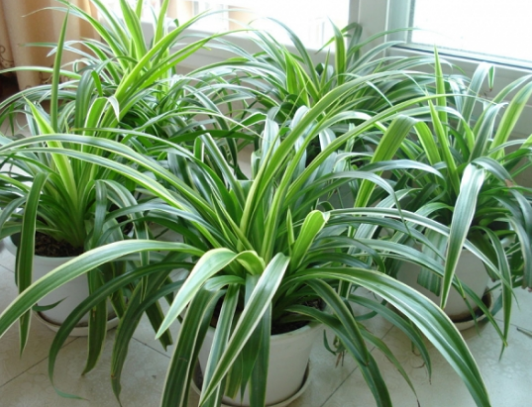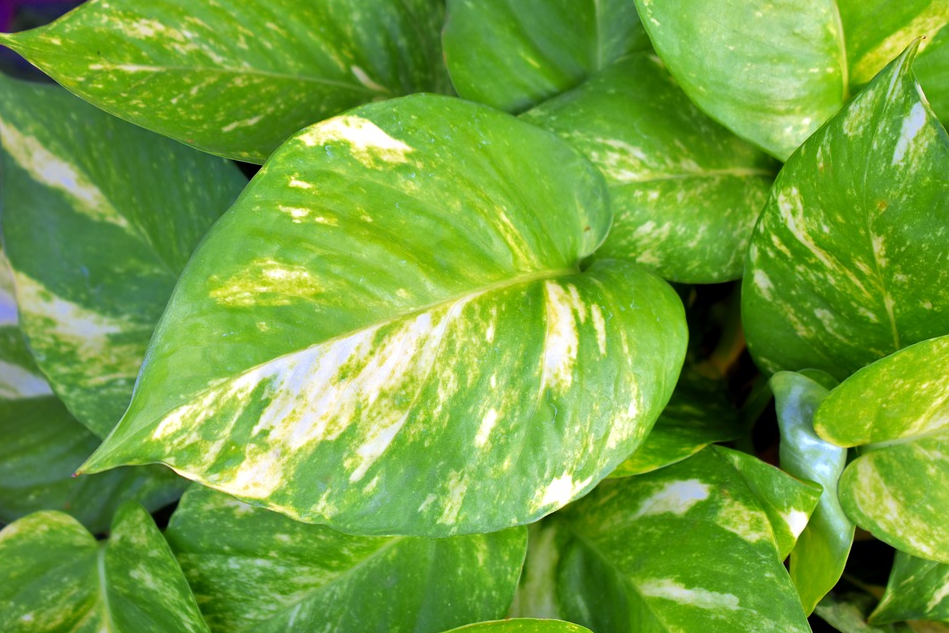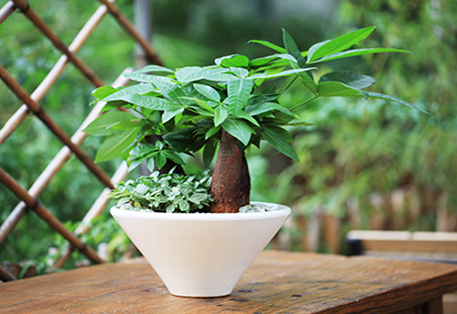How to raise hanging orchids? What if the leaves turn yellow? Can you put it in the bedroom?
Cymbidium is easy to breed and adaptable, and it is one of the most traditional indoor hanging plants. Its leaves are slender and soft, and small plants are drawn from the axils of the leaves, hanging from the basin, stretching and hanging, like flowers, evergreen all the year round. So how to raise hanging orchids? What if the leaves turn yellow? Can you put it in the bedroom?

I. the culture method of Cymbidium
1. Basin soil selection
When the orchid is cultivated, it can be cultivated in clay flowerpots, plastic pots, porcelain pots and pottery pots. If you want to hang cultivation, you should choose a flowerpot with hooks. The size of the flowerpot should be selected according to the growth status of the orchid. Generally, it is necessary to choose something slightly larger than the plant to give the orchid growth space.
Cymbidium has strong adaptability to all kinds of soil and is easy to cultivate. Fertile sandy loam, humus, peat, or fine sandy soil can be used as potted soil, and a certain amount of base fertilizer can be applied before planting.
The hanging orchid usually changes the basin once every 2-3 years, and it is carried out in March every year.
two。 Light and temperature
The hanging orchid likes the semi-shady environment and is more afraid of direct sunshine. when the sun is strong in summer and autumn, the strong light will cause the leaves to wither and yellow, or even the whole plant to die. So pay attention to shade in summer, put the orchid in a cool and ventilated place, and pay attention to maintaining the humidity of the environment. In winter, it is necessary to let the orchid accept some direct sunlight properly.
Cymbidium likes warm climate and is not resistant to severe cold and heat. The most suitable growth temperature is between 15 ℃ and 25 ℃, and the overwintering temperature in winter can not be lower than 5 ℃. It is necessary to do a good job of heat prevention and cooling in summer, and pay attention to cold prevention and heat preservation when the winter temperature is lower than 5 mi 7 ℃.
3. Watering and fertilizing
The hanging orchid likes the wet environment, should pay attention to keep the basin soil moist. In summer, watering should be adequate, and spray water on the branches and leaves every evening to keep the air moist. When the winter temperature is below 5 ℃, less watering, basin soil should not be too wet, otherwise the leaves will easily turn yellow. Usually to maintain normal humidity, should not be dry, should not be too wet.
Hanging orchid in the spring and autumn growth season, every half a month or so to apply rarefied liquid fertilizer, mainly organic fertilizer. During high temperature in summer and dormancy in winter, topdressing should be stopped. The varieties of flowers and leaves should apply less nitrogen fertilizer, otherwise the markings on the leaves will become lighter and affect the ornamental effect.
4. Reproduction method
Cymbidium can be propagated by cutting, ramet, sowing and other methods. Cutting propagation and split propagation can be carried out at any time from spring to autumn, and sowing propagation is mainly carried out in March every year.
II. Matters needing attention in Cymbidium culture
1. Pruning
Hanging orchid maintenance should pay attention to pruning at ordinary times, cut off yellow leaves at any time, and can be combined with changing pots to cut off old roots, rotten roots and excess fibrous roots. The old leaves of Cymbidium can be trimmed in the first and middle of May every year.
two。 Pest control
Cymbidium culture is generally not prone to diseases and insect pests. However, there will be due to stagnant water in basin soil, poor ventilation caused by root rot, as well as shell insects, aphids, whitefly, mites and other pests, timely spray control.
3. Breeding taboo
The hanging orchid is resistant to high temperature and can not bear the hot sun, such as the sun is strong, the leaves of the hanging orchid are easy to burn and need shade in summer. The family can place the orchid in a brightly lit room to watch. In summer, water supply should be strengthened and water should be sprinkled frequently to increase air humidity.
Cymbidium is not cold-resistant and can survive the winter safely at room temperature above 5 ℃. When the temperature is low in winter, the orchid should be placed in full light, watering should be less, so that the basin soil is slightly partial, not fertilizing.
Third, the causes and solutions of the yellowing of the leaves of Cymbidium
1. Hypertrophy and burning seedlings
Friends who love flowers may be too kind to hanging orchids! If you put too much fertilizer, you know, although fertilizer is a good thing, you should know that if you fertilize too much, the fertilizer that the orchid cannot absorb, the rest of the fertilizer will burn out the roots of the orchid, reflected in the rest of the orchid, that is, the leaves turn yellow.
Solution.
Stop fertilizing immediately, irrigate clean water, or turn over the basin to change soil. In addition, we should also pay attention to the usual fertilization.
Cymbidium usually does not have a great demand for flower fertilizer, if you want to grow vigorously, you can use bean dregs to soak in water and dilute it after full fermentation. Can also use a little compound fertilizer, preferably organic fertilizer, nitrogen, phosphorus and potassium compound fertilizer is the best, once every half a month. When the temperature is below 4 degrees Celsius, the orchid should stop fertilizing.
two。 Too much light
Cymbidium is a semi-overcast flower, so whether to bask in the sun or not has become a tangled problem for all flower friends. Cymbidium has to bask in the sun, which will lead to the reduction of chlorophyll in the leaves and the yellowing of the leaves. But also cannot carry on the sunlight exposure, that is the torture to the hanging orchid, if the sun is too strong, the hanging orchid will be "dried" oh ~ the leaves will turn yellow!
Solution.
We need to let the orchid be exposed to astigmatism for at least four hours a day, or we can put the orchid under the indoor incandescent lamp or on the balcony. When the sun is very strong in summer, put the orchid in the shade and do not expose yourself to the sun.
3. Improper watering
The hanging orchid likes the wet environment, the basin soil can not be too dry, but this does not mean to water the hanging orchid all the time! Watering the orchid is also limited, too much watering, coupled with the basin soil drainage is not smooth to cause stagnant water, the root system of the orchid can not breathe, reflected on the leaves is the leaves yellowing!
Another reason is that the hanging orchid is watertight for a long time, resulting in the loss of water at the root of the hanging orchid, and the lower old leaves will turn yellow.
Solution.
Water too much to timely loosen the soil and control moisture, and usually watering must be thoroughly. In addition, the usual watering method is also written below.
Hanging orchids are not suitable for watering every day, so flower friends can be "lazy"! In general, the orchid is watered once every ten days in winter and every five days depending on the dry condition in summer. It should be thoroughly watered and drained smoothly.
If the air is dry, you can often spray and wash the branches and leaves with a sprayer, which can not only increase the air humidity, but also prevent the dry tip of the leaves, but also keep the leaves clean, improve the ornamental, and get more with one stone.
In addition, watering time flower friends should pay attention to, it is best to water in the morning or evening, can not be watered at noon, a hot day suddenly to the hanging orchid basin cold water, will be cold, catch a cold. Also, during the growing period, the amount of water can be increased appropriately, but not too much.
4. Temperature discomfort
The suitable temperature for the growth of Cymbidium is 15-25 ℃, the fastest growth is when the temperature is 20-24 ℃, the growth stops above 30 ℃, and the overwintering temperature is 5 ℃. If the temperature is too low, it will also be reflected on the leaves of the orchid. So, flower friends in the north must remember that the orchid moves indoors in winter.
Solution.
The best solution, of course, is to give the orchid a suitable temperature ~ the most suitable growth temperature is 20-24 ℃. Usually I think it's good to keep this temperature.
5. Lack of nutrition
I don't know if you have ignored the most fundamental problem of hanging orchid, potted soil.
All the nutrients needed by the orchid come from the soil where it takes root, so if the potted soil is not replaced for a long time, some elements that we are easy to ignore will gradually disappear, and the orchid will lose the nutrients needed for growth. and all the "discomfort" of the orchid will be reflected in its leaves, and the leaves will turn yellow.
Solution.
Of course, the best way to solve this problem is to change the basin for the orchid. Remember to mix fertilizer when changing the basin to avoid the loss of fertilizer and burning roots.
Can you put the orchid in the bedroom
The orchid can be put in the bedroom.
The freshness and elegance of the bedroom can make people feel at ease, the bedroom full of green, let the person's rest get the best experience. The air purification function of the hanging orchid makes the air in your bedroom fresh.
Therefore, the hanging orchid can be put in the bedroom. But to choose a slightly smaller adult plant, the number of pots should be 1-2 pots. It's best to put it on the windowsill or on the wall opposite the bed. Not only eliminate everyone's doubts, but also meet the needs of fresh air in the bedroom, but also let the hanging orchid grow very well. To kill three birds with one arrow, of course we should do it quickly!
Nowadays, the air pollution in the social environment is particularly serious, so it is a good choice to put a pot of orchid in the child's room, which can not only be used as an ornament, but also purify the air. Children's more exposure to green plants is conducive to their mental expansion and good growth.
However, attention should be paid to indoor ventilation to keep the plants growing healthily. If the child has a cold, it is advisable to move the orchid to another room during the cold stage. When a child has a cold, serious nasal congestion will affect his or her breathing, and moving the plant out at night will help the child to breathe smoothly.
Fifth, hanging orchid bedroom with fengshui
The bedroom should be clean, serene and warm. Can use hanging orchid, lily, evening fragrant jade, calla lily and so on suitable to put in the bedroom plant decoration. Put hanging orchid in the bedroom, can make husband and wife relationship is harmonious, body and mind can get rest in warmth, quiet. It is best to hang the orchid on the opposite side of the bed. When you sit and read on the bed, you can take a look at the flowers on the wall and be pleasing to the eye. Hey, relax your eyeballs.
Of course, the bedroom windowsill facing the sun, can be placed directly on the left side of the bedroom windowsill, with the left as the respect, can let the hanging orchid grow very strong, add interest to your bedroom.
Time: 2019-04-05 Click:
- Prev

What if the green pineapple leaves turn yellow? How do you grow up fast?
Green pineapple is tenacious in vitality, living in the face of water, also known as the flower of life, can climb on the cylinder to grow, can also be directly potted in the indoor viewing, almost everyone's home will raise a pot, but there will often be leaves yellowing. What if the green pineapple leaves turn yellow? How to grow up fast
- Next

How is the leaf of the rich tree yellow to return a responsibility? What shall I do? How to prevent it?
The rich tree is a popular potted plant, which not only represents getting rich, but also a natural air purifier, which can fight against the exhaust gas produced by tobacco burning, and is an important household furnishings. Many people like to put a pot in their home, only to find that the leaves turn yellow soon.
Related
- Fuxing push coffee new agricultural production and marketing class: lack of small-scale processing plants
- Jujube rice field leisure farm deep ploughing Yilan for five years to create a space for organic food and play
- Nongyu Farm-A trial of organic papaya for brave women with advanced technology
- Four points for attention in the prevention and control of diseases and insect pests of edible fungi
- How to add nutrient solution to Edible Fungi
- Is there any good way to control edible fungus mites?
- Open Inoculation Technology of Edible Fungi
- Is there any clever way to use fertilizer for edible fungus in winter?
- What agents are used to kill the pathogens of edible fungi in the mushroom shed?
- Rapid drying of Edible Fungi

